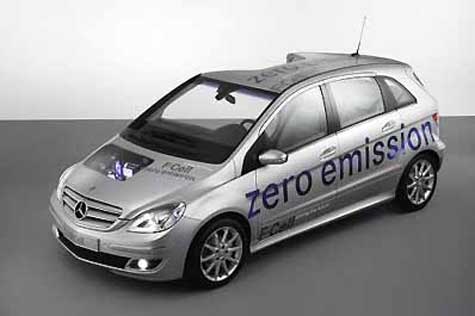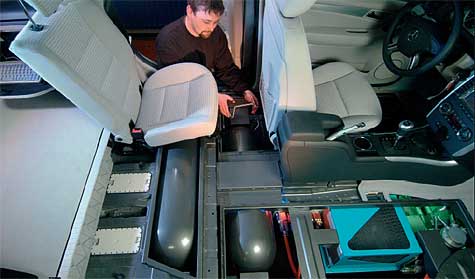
Mercedes-Benz B-Class F-CELL

Mercedes-Benz has improved upon the 60 F-Cell A-Class test vehicles that have been rolled out to United States, Japan, Germany and Singapore with what else, the F-Cell B-Class. The newest DaimlerChrysler Mercedes-Benz F-Cell B-Class offers more power and extended range (inside of its sports tourer segment) over the earlier A-Class version.
 DaimlerChrysler Mercedes-Benz B-Class F-Cell Tourer |
The electric motor of the Mercedes-Benz F-Cell Sports Tourer generates 100kw (136hp), which is 35kw (48hp) more than the A-Class version. Due to reduced fuel consumption and increased storage capacity, the driving range of the F-Cell Sports Tourer has also been increased to 250 miles, which is more than double that of the F-Cell A-Class vehicles.
According to Dr. Thomas Weber, member of DaimlerChrysler's Board of Management with responsibility for Research and Technology and for the development of the Mercedes Car Group, "With this car, we are continuing our highly successful practical tests on an even larger scale."
The Mercedes-Benz F-Cell Sports Tourer was developed as an automobile for family, travel and leisure offering the same sandwich concept that many hydrogen car manufacturers are going towards, which places the fuel cell and other components under the floorpan, sandwiched in the vehicles double underbody, in order to maximize roominess and comfort for the passengers.
The Mercedes-Benz F-Cell Sports Tourer is also a hybrid vehicle as well, using battery power to start the vehicle and assist the hydrogen fuel cell in delivering power to the electric motors during acceleration. The battery pack is also recharged by the fuel cell and with regenerative braking indicative of other hybrid vehicles.
 Inside the F-Cell B-Class Tourer |
The Mercedes F-Cell B-Class was first unveiled at the 2005 Geneva Motor Show in Switzerland. In Geneva, it was demonstrated that the F-Cell B-Class Tourer uses modular design as a step toward marketability. The components have been designed in such a way as to provide easy access and removal for servicing. According to Mercedes representative Peter Heim, "We pared away the body shell in such a way that people can see the major components of the fuel cell drive, and that helps them to understand the principle behind it. In order to ensure that people are able to form a clear and concrete idea about how the fuel cell drive works, it's very important that future components should be presented as realistically and as close to the series-production stage as possible."
The Mercedes-Benz F-Cell Sports Tourer offers quite a leap in technology over its predecessor and with new developments happening all the time, its only a matter of time until the newest hydrogen Mercedes vehicle hits the showroom floors.
No comments:
Post a Comment